#best fpga design software
Explore tagged Tumblr posts
Text
High Performance FPGA Solutions
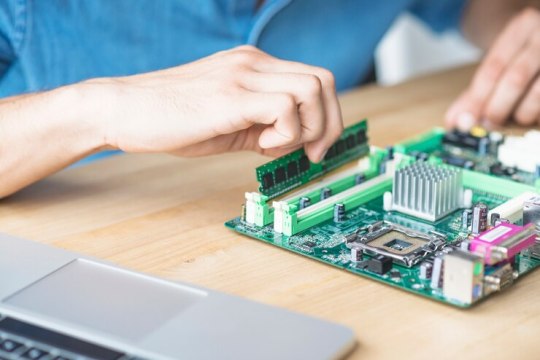
In today's rapidly evolving technological landscape, the demand for high-performance solutions is ever-increasing. Field-Programmable Gate Arrays (FPGAs) have emerged as versatile tools offering customizable hardware acceleration for a wide range of applications. Let's delve into the world of high performance FPGA solutions, exploring their key features, applications, challenges, recent advances, case studies, and future trends.
Introduction to High Performance FPGA Solutions
Definition of FPGA
Field-Programmable Gate Arrays (FPGAs) are semiconductor devices that contain an array of programmable logic blocks and configurable interconnects. Unlike Application-Specific Integrated Circuits (ASICs), FPGAs can be programmed and reprogrammed after manufacturing, allowing for flexibility and customization.
Importance of High Performance in FPGA Solutions
High performance is crucial in FPGA solutions to meet the demanding requirements of modern applications such as real-time data processing, artificial intelligence, and high-frequency trading. Achieving optimal speed, throughput, and efficiency is paramount for maximizing the effectiveness of FPGA-based systems.
Key Features of High Performance FPGA Solutions
Speed and Throughput
High performance FPGA solutions are capable of executing complex algorithms and processing vast amounts of data with exceptional speed and efficiency. This enables real-time decision-making and rapid response to dynamic inputs.
Low Latency
Reducing latency is essential in applications where response time is critical, such as financial trading or telecommunications. High performance FPGAs minimize latency by optimizing data paths and processing pipelines.
Power Efficiency
Despite their high performance capabilities, FPGA solutions are designed to operate within strict power constraints. Advanced power management techniques ensure optimal performance while minimizing energy consumption, making FPGAs suitable for battery-powered or energy-efficient devices.
Flexibility and Reconfigurability
One of the key advantages of FPGAs is their inherent flexibility and reconfigurability. High performance FPGA solutions can adapt to changing requirements by reprogramming the hardware on-the-fly, eliminating the need for costly hardware upgrades or redesigns.
Applications of High Performance FPGA Solutions
Data Processing and Analytics
FPGAs excel in parallel processing tasks, making them ideal for accelerating data-intensive applications such as big data analytics, database management, and signal processing.
Artificial Intelligence and Machine Learning
The parallel processing architecture of FPGAs is well-suited for accelerating AI and ML workloads, including model training, inference, and optimization. FPGAs offer high throughput and low latency, enabling real-time AI applications in edge devices and data centers.
High-Frequency Trading
In the fast-paced world of financial markets, microseconds can make the difference between profit and loss. High performance FPGA solutions are used to execute complex trading algorithms with minimal latency, providing traders with a competitive edge.
Network Acceleration
FPGAs are deployed in network infrastructure to accelerate packet processing, routing, and security tasks. By offloading these functions to FPGA-based accelerators, network performance and scalability can be significantly improved.
Challenges in Designing High Performance FPGA Solutions
Complexity of Design
Designing high performance FPGA solutions requires expertise in hardware architecture, digital signal processing, and programming languages such as Verilog or VHDL. Optimizing performance while meeting timing and resource constraints can be challenging and time-consuming.
Optimization for Specific Tasks
FPGAs offer a high degree of customization, but optimizing performance for specific tasks requires in-depth knowledge of the application domain and hardware architecture. Balancing trade-offs between speed, resource utilization, and power consumption is essential for achieving optimal results.
Integration with Existing Systems
Integrating FPGA-based accelerators into existing hardware and software ecosystems can pose compatibility and interoperability challenges. Seamless integration requires robust communication protocols, drivers, and software interfaces.
Recent Advances in High Performance FPGA Solutions
Improved Architectures
Advancements in FPGA architecture, such as larger logic capacity, faster interconnects, and specialized processing units, have led to significant improvements in performance and efficiency.
Enhanced Programming Tools
New development tools and methodologies simplify the design process and improve productivity for FPGA developers. High-level synthesis (HLS) tools enable software engineers to leverage FPGA acceleration without requiring expertise in hardware design.
Integration with Other Technologies
FPGAs are increasingly being integrated with other technologies such as CPUs, GPUs, and ASICs to create heterogeneous computing platforms. This allows for efficient partitioning of tasks and optimization of performance across different hardware components.
Case Studies of Successful Implementation
Aerospace and Defense
High performance FPGA solutions are widely used in aerospace and defense applications for tasks such as radar signal processing, image recognition, and autonomous navigation. Their reliability, flexibility, and performance make them ideal for mission-critical systems.
Telecommunications
Telecommunications companies leverage high performance FPGA solutions to accelerate packet processing, network optimization, and protocol implementation. FPGAs enable faster data transfer rates, improved quality of service, and enhanced security in telecommunication networks.
Financial Services
In the highly competitive world of financial services, microseconds can translate into significant profits or losses. High performance FPGA solutions are deployed in algorithmic trading, risk management, and low-latency trading systems to gain a competitive edge in the market.
Future Trends in High Performance FPGA Solutions
Increased Integration with AI and ML
FPGAs will play a vital role in accelerating AI and ML workloads in the future, especially in edge computing environments where low latency and real-time processing are critical.
Expansion into Edge Computing
As the Internet of Things (IoT) continues to grow, there will be increasing demand for high performance computing at the edge of the network. FPGAs offer a compelling solution for edge computing applications due to their flexibility, efficiency, and low power consumption.
Growth in IoT Applications
FPGAs will find widespread adoption in IoT applications such as smart sensors, industrial automation, and autonomous vehicles. Their ability to handle diverse workloads, adapt to changing requirements, and integrate with sensor networks makes them an ideal choice for IoT deployments.
Conclusion
In conclusion, high performance FPGA solutions play a crucial role in driving innovation and accelerating the development of advanced technologies. With their unparalleled speed, flexibility, and efficiency, FPGAs enable a wide range of applications across industries such as aerospace, telecommunications, finance, and IoT. As technology continues to evolve, the demand for high performance FPGA solutions will only continue to grow, shaping the future of computing.
0 notes
Text
Hell is terms like ASIC, FPGA, and PPU
I haven't been doing any public updates on this for a bit, but I am still working on this bizarre rabbit hole quest of designing my own (probably) 16-bit game console. The controller is maybe done now, on a design level. Like I have parts for everything sourced and a layout for the internal PCB. I don't have a fully tested working prototype yet because I am in the middle of a huge financial crisis and don't have the cash laying around to send out to have boards printed and start rapidly iterating design on the 3D printed bits (housing the scroll wheel is going to be a little tricky). I should really spend my creative energy focusing on software development for a nice little demo ROM (or like, short term projects to earn money I desperately need) but my brain's kinda stuck in circuitry gear so I'm thinking more about what's going into the actual console itself. This may get techie.
So... in the broadest sense, and I think I've mentioned this before, I want to make this a 16-bit system (which is a term with a pretty murky definition), maybe 32-bit? And since I'm going to all this trouble I want to give my project here a little something extra the consoles from that era didn't have. And at the same time, I'd like to be able to act as a bridge for the sort of weirdos who are currently actively making new games for those systems to start working on this, on a level of "if you would do this on this console with this code, here's how you would do it on mine." This makes for a hell of a lot of research on my end, but trust me, it gets worse!
So let's talk about the main strengths of the 2D game consoles everyone knows and loves. Oh and just now while looking for some visual aids maybe I stumbled across this site, which is actually great as a sort of mid-level overview of all this stuff. Short version though-
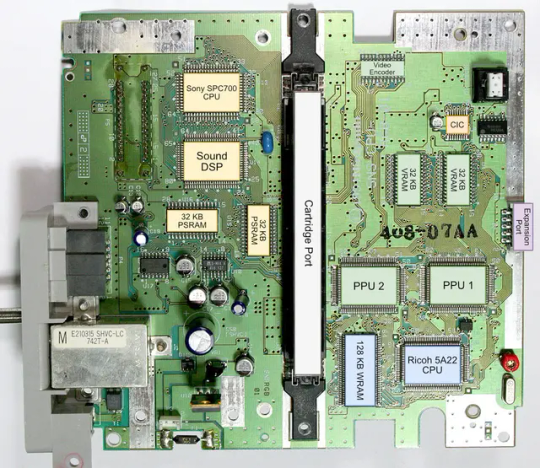
The SNES (or Super Famicom) does what it does by way of a combination of really going all in on direct memory access, and particularly having a dedicated setup for doing so between scanlines, coupled with a bunch of dedicated graphical modes specialized for different use cases, and you know, that you can switch between partway through drawing a screen. And of course the feature everyone knows and loves where you can have one polygon and do all sorts of fun things with it.
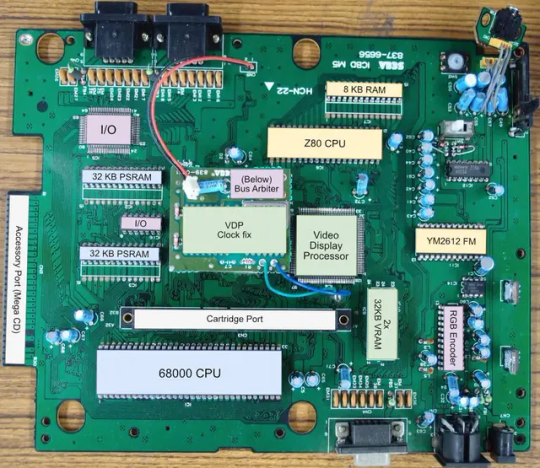
The Genesis (or Megadrive) has an actual proper 16-bit processor instead of this weird upgraded 6502 like the SNES had for a scrapped backwards compatibility plan. It also had this frankly wacky design where they just kinda took the guts out of a Sega Master System and had them off to the side as a segregated system whose only real job is managing the sound chip, one of those good good Yamaha synths with that real distinct sound... oh and they also actually did have a backwards compatibility deal that just kinda used the audio side to emulate an SMS, basically.
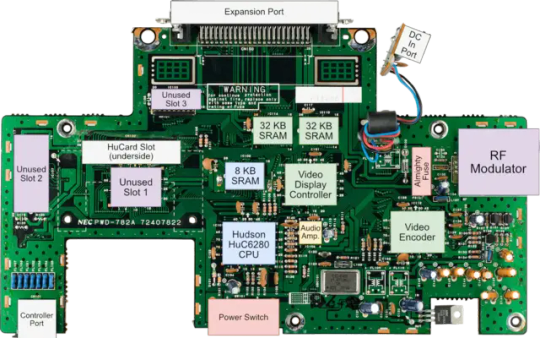
The TurboGrafix-16 (or PC Engine) really just kinda went all-in on making its own custom CPU from scratch which...we'll get to that, and otherwise uh... it had some interesting stuff going on sound wise? I feel like the main thing it had going was getting in on CDs early but I'm not messing with optical drives and they're no longer a really great storage option anyway.
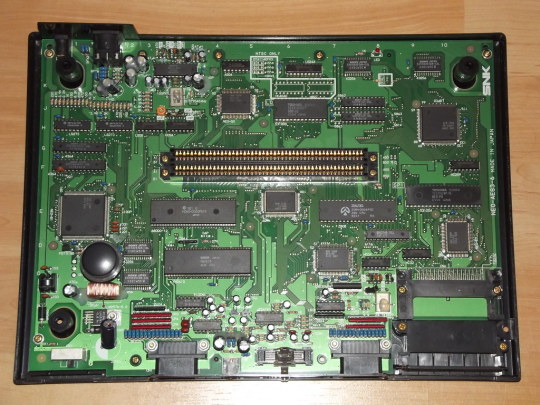
Then there's the Neo Geo... where what's going on under the good is just kind of A LOT. I don't have the same handy analysis ready to go on this one, but my understanding is it didn't really go in for a lot of nice streamlining tricks and just kinda powered through. Like it has no separation of background layers and sprites. It's just all sprites. Shove those raw numbers.
So what's the best of all worlds option here? I'd like to go with one of them nice speedy Motorolla processors. The 68000 the Genesis used is no longer manufactured though. The closest still-in-production equivalent would be the 68SEC000 family. Seems like they go for about $15 a pop, have a full 32-bit bus, low voltage, some support clock speeds like... three times what the Genesis did. It's overkill, but should remove any concerns I have about having a way higher resolution than the systems I'm jumping off from. I can also easily throw in some beefy RAM chips where I need.
I was also planning to just directly replicate the Genesis sound setup, weird as it is, but hit the slight hiccup that the Z80 was JUST discontinued, like a month or two ago. Pretty sure someone already has a clone of it, might use that.
Here's where everything comes to a screeching halt though. While the makers of all these systems were making contracts for custom processors to add a couple extra features in that I should be able to work around by just using newer descendant chips that have that built in, there really just is no off the shelf PPU that I'm aware of. EVERYONE back in the day had some custom ASIC (application-specific integrated circuit) chip made to assemble every frame of video before throwing it at the TV. Especially the SNES, with all its modes changing the logic there and the HDMA getting all up in those mode 7 effects. Which are again, something I definitely want to replicate here.
So one option here is... I design and order my own ASIC chips. I can probably just fit the entire system in one even? This however comes with two big problems. It's pricy. Real pricy. Don't think it's really practical if I'm not ordering in bulk and this is a project I assume has a really niche audience. Also, I mean, if I'm custom ordering a chip, I can't really rationalize having stuff I could cram in there for free sitting outside as separate costly chips, and hell, if it's all gonna be in one package I'm no longer making this an educational electronics kit/console, so I may as well just emulate the whole thing on like a raspberry pi for a tenth of the cost or something.
The other option is... I commit to even more work, and find a way to reverse engineer all the functionality I want out with some big array of custom ROMs and placeholder RAM and just kinda have my own multi-chip homebrew co-processors? Still PROBABLY cheaper than the ASIC solution and I guess not really making more research work for myself. It's just going to make for a bigger/more crowded motherboard or something.
Oh and I'm now looking at a 5V processor and making controllers compatible with a 10V system so I need to double check that all the components in those don't really care that much and maybe adjust things.
And then there's also FPGAs (field programmable gate arrays). Even more expensive than an ASIC, but the advantage is it's sort of a chip emulator and you can reflash it with something else. So if you're specifically in the MiSTer scene, I just host a file somewhere and you make the one you already have pretend to be this system. So... good news for those people but I still need to actually build something here.
So... yeah that's where all this stands right now. I admit I'm in way way over my head, but I should get somewhere eventually?
11 notes
·
View notes
Text
Boost Your VLSI Career with the Best Training Institutes in Bangalore
The Rising Demand for VLSI Professionals With the exponential growth of the semiconductor industry, VLSI (Very Large Scale Integration) design has emerged as one of the most in-demand fields in electronics and embedded systems. From smartphones and computers to self-driving cars and smart appliances, VLSI technology plays a crucial role in enabling intelligent digital systems. Due to the increasing dependency on integrated circuits in almost every electronic device, there is a rising need for skilled VLSI professionals. This demand has led many aspiring engineers to seek quality training from reputed institutes in Bangalore, India’s hub for technology and innovation.
Why Bangalore is the Preferred Destination for VLSI Training Bangalore, often called the Silicon Valley of India, is home to numerous semiconductor companies, design houses, and electronics manufacturing firms. This environment creates ample opportunities for practical exposure and industry collaboration. Among the top vlsi institutes in bangalore, candidates can find a range of training programs that combine theoretical knowledge with hands-on lab experience. These institutes offer specialized courses in areas like digital design, physical design, ASIC verification, and FPGA implementation, catering to the evolving needs of the industry. Choosing the right institute in Bangalore gives learners a valuable edge in both knowledge and employment prospects.
Features of an Effective VLSI Training Program An ideal VLSI training program is structured to provide not only strong foundational concepts but also practical exposure using real-time tools and industry-standard software. Courses designed in alignment with current job roles help learners understand design flows, verification methodologies, and layout processes. Instructors with industry experience and the availability of live projects further enhance the learning experience. Institutes that offer placement support, interview preparation, and resume guidance are often preferred by candidates aiming for a stable career in VLSI.
The Role of VLSI Training in Career Advancement Fresh graduates and working professionals who wish to enter the semiconductor domain can significantly benefit from VLSI training. These programs are crafted to develop technical proficiency and make learners job-ready. Bangalore provides a dynamic setting where individuals can access the latest tools, interact with domain experts, and build a professional network. A focused VLSI training program in this city can open the door to numerous job opportunities in top semiconductor firms.
Choosing a Job-Oriented VLSI Institute Enrolling in a job oriented vlsi training institute in bangalore can be a game-changer for anyone aiming to enter the core electronics field. Such institutes focus on equipping students with industry-relevant skills and practical expertise, thus improving their employability. These job-oriented programs emphasize real-world applications, timely projects, and guidance that align with current hiring trends in the VLSI sector.
Conclusion VLSI is a promising field with ever-expanding opportunities. For aspiring engineers looking to start or grow their careers in this domain, choosing the right training institute is critical. Bangalore stands out as a prime destination due to its strong industry presence and top-quality education providers. One of the most trusted names in this space is Takshila Institute of VLSI Technologies, known for offering robust, industry-aligned training. From comprehensive curriculum to placement support, the right institute can significantly impact an individual's career path. In conclusion, selecting the best institute from the top vlsi institutes in bangalore or opting for a job oriented vlsi training institute in bangalore can be the key step toward a successful future in the semiconductor industry.
0 notes
Text
Get to know the Best College in Rajasthan in Electronics & Communication!

Introduction
Electronics & Communication Engineering (ECE) isn’t just a degree—it’s the backbone of the modern digital world. From smartphones and satellites to smart cities and autonomous vehicles, ECE powers the innovation around us. But here’s the catch: your success in this dynamic field largely depends on where you study. So, which is the Best Electronics & Communication Engineering College in Rajasthan? Buckle up as we take you on a deep dive!
What is Electronics & Communication Engineering (ECE)?
ECE is the fusion of two rapidly evolving domains—electronics and communication systems. It teaches you how electronic devices are built and how data travels through them.
Core Subjects You’ll Study:
Analog & Digital Electronics
Microprocessors & Microcontrollers
Communication Systems
Signal Processing
VLSI Design
Embedded Systems
Internet of Things (IoT)
Skills You Gain:
Problem-solving & analytical thinking
Circuit design & simulation
Coding in C/C++/Python
Communication protocols & networking
Career Scope After ECE
Let’s talk big picture. What happens after you graduate?
Industries That Hire ECE Grads:
Telecom
Consumer Electronics
Aerospace & Defense
IT & Software
Healthcare Devices
Automation & Robotics
Govt vs. Private Sector:
PSUs like ISRO, DRDO, and BEL are dream destinations in the government sector. Giants like Infosys, Qualcomm, and Intel come knocking in the private sector.
Future-Forward Careers:
IoT Developer
Embedded Systems Engineer
AI & ML Engineer
VLSI Designer
Network Security Specialist
Key Features of a Top ECE College
Choosing the right college is like choosing the right gear for a long journey. Here’s what to look for:
Accreditation & Recognition
Top ECE colleges in Rajasthan should be AICTE-approved, NBA-accredited, and affiliated with reputed universities.
Industry-Ready Curriculum
Updated syllabus, practical-oriented labs, and elective options to explore emerging tech trends.
Labs & Research
Advanced labs with FPGA kits, simulation tools, PCB design software, and robotics stations.
Internships & Placements
Look for colleges that partner with tech giants, provide hands-on internships, and have a proven placement track record.
The Best College in Rajasthan for ECE Revealed
One institution consistently turns heads with its stellar faculty, modern infrastructure, and top-notch placements—Stani Memorial College of Engineering & Technology (SMCET), Jaipur.
Why SMCET Stands Out:
20+ years of excellence in technical education
Personalized mentorship programs
Regular workshops with companies like TCS, Wipro, and Siemens
Faculty Excellence:
Ph.D.-qualified professors, industry veterans, and supportive teaching staff who make learning engaging and career-focused.
Academic Curriculum Breakdown
Year 1:
Engineering Basics
Applied Physics & Mathematics
Programming Fundamentals
Years 2 & 3:
ECE Core Subjects
Mini Projects & Lab Work
Industrial Visits
Final Year:
Specializations (AI, IoT, VLSI)
Capstone Projects
Internship + Final Placement
Infrastructure That Inspires Innovation
At SMCET, infrastructure isn't just about buildings—it’s about experiences.
ECE Labs:
Digital Signal Processing Lab
Communication Systems Lab
Embedded Systems & IoT Lab
Beyond Labs:
Tech-enabled classrooms
Digital library with IEEE journals
Entrepreneurship incubation center
Campus Life Beyond the Classroom
SMCET believes in all-around development.
Clubs & Societies:
Robotics Club
Coding Club
ECE Innovation Circle
Cultural & Sports Fests:
Annual events like “Technotsav” and inter-college tournaments make life vibrant!
Placement Powerhouse
Top Recruiters:
Infosys
TCS
Wipro
Ericsson
Bosch
Placement Highlights:
90 %+ placement rate in ECE
Industry-aligned training from the 3rd year
Alumni in Fortune 500 companies
Admission Process
Eligibility:
10+2 with Physics, Chemistry & Math
Min. 45-50% marks
Entrance Exams:
REAP (Rajasthan Engineering Admission Process)
JEE Main score preferred for merit
How to Apply:
Online/offline application via the official website
Keep documents like mark sheets, photo ID, and entrance exam score ready
Scholarships & Financial Aid
Merit-Based Scholarships:
For high-performing students in the 12th grade and entrance exams
Govt Schemes:
AICTE Pragati (for girls)
Saksham (for differently-abled students)
Rajasthan state scholarships
What Students & Alumni Say
Choosing SMCET was the best decision for my ECE career. The faculty genuinely care about your growth!” — Priyanka, ECE 2022
“From lab work to internships, everything is hands-on and industry-relevant.” — Aman, ECE Alumni at Ericsson.
Why Rajasthan is a Rising Tech-Edu Hub
Rajasthan isn’t just about forts and deserts anymore. With cities like Jaipur becoming education & IT hubs, studying here offers the perfect mix of tradition, innovation, and career opportunities.
How to Prepare for a Future in ECE
Stay updated with trends like AI, 5G & VLSI
Participate in tech fests and hackathons
Take online certifications in embedded systems or IoT
Practice coding regularly on platforms like HackerRank
Conclusion
If you’re passionate about technology, innovation, and creating real-world impact, then ECE is your gateway. And when it comes to pursuing it in Rajasthan, Stani Memorial College of Engineering & Technology, Jaipur, sets the gold standard. From faculty and labs to placements and student life, it ticks every box.
So, ready to power your future with circuits and code? Choose excellence. Choose SMCET.
FAQs
Q1: Is Electronics & Communication Engineering a good career choice in 2025 and beyond?
Yes! With tech evolving rapidly, ECE offers roles in AI, IoT, robotics, and telecom industries that are booming globally.
Q2: Which is the best private college in Rajasthan for ECE?
Stani Memorial College of Engineering & Technology (SMCET), Jaipur, is widely recognized for its excellence in ECE.
Q3: What is the average placement package in ECE?
Depending on skills and internships, ECE graduates can expect packages ranging from ₹3.5 to ₹10+ LPA.
Q4: Can I pursue higher studies after ECE?
Absolutely. You can go for M.Tech, MBA, or MS abroad in specializations like VLSI, AI, or Communication Systems.
Q5: Does ECE require coding?
Yes, but not just coding—ECE combines hardware with software. Languages like C, Python, and MATLAB are often used.
1 note
·
View note
Text
Unlocking a Brighter Future with VLSI: The Gateway to Chip Design Careers
Introduction to the World of VLSI
Very-Large-Scale Integration (VLSI) has revolutionized the world of electronics by enabling the design and development of integrated circuits with millions of transistors. In today’s digital age, everything from smartphones to autonomous vehicles relies on VLSI technologies. This field not only drives innovation but also creates abundant career opportunities for aspiring engineers. With industries increasingly demanding skilled professionals, VLSI training has become a cornerstone for electronics and electrical graduates aiming to shape the future. Pursuing a specialized program in VLSI is essential for gaining hands-on knowledge and mastering the nuances of chip design, verification, and semiconductor technology. For students eager to make a mark in this high-growth domain, starting with foundational training sets the stage for long-term success.
Importance of Practical VLSI Skills
Theoretical knowledge alone is not sufficient to thrive in the VLSI industry. Employers look for candidates who can demonstrate real-world problem-solving skills using tools and methodologies used in modern chip design. This is where practical training becomes invaluable. Training programs that emphasize industry-relevant experience help bridge the gap between academic learning and corporate expectations. The best vlsi training institute in hyderabad offers a curriculum that mirrors actual work scenarios, equipping students with expertise in ASIC and FPGA design, physical verification, and layout techniques. These institutes use advanced software tools and simulations, ensuring learners are ready to step into the semiconductor industry with confidence. Practical exposure increases job readiness and boosts the chances of landing lucrative roles in top organizations.
Why Job-Oriented VLSI Training Matters
In a competitive job market, simply completing a degree in electronics or electrical engineering may not be enough. Employers often prefer candidates who have undergone rigorous, job-focused training. A vlsi job oriented training in hyderabad prepares students to meet these expectations head-on. These programs are tailored to align with the current hiring needs of chip design companies, offering modules in RTL coding, verification, and DFT (Design for Testability). They also include placement support, mock interviews, and resume-building sessions, which make students more attractive to recruiters. Such job-oriented training ensures learners understand both the theoretical and practical aspects of VLSI, thus standing out among a pool of generic applicants. It helps them build confidence while transitioning from academic settings into full-time employment.
Career Prospects After VLSI Training
After completing a comprehensive VLSI course, a wide array of career paths opens up for students. From design engineer to verification specialist, physical design engineer to embedded systems developer, the opportunities are diverse and promising. The semiconductor sector continues to grow with advancements in AI, IoT, and 5G, all of which depend heavily on VLSI technology. With the right training, candidates can secure roles in both multinational corporations and domestic startups. Furthermore, continuous learning and certification can lead to rapid career progression and global opportunities. Students who invest in specialized VLSI training often find themselves ahead of their peers, both in terms of skills and job prospects. A structured learning path also gives them the clarity to choose roles that align with their interests and strengths.
Conclusion: Choose the Right Platform
To excel in the VLSI industry, one must invest in quality education that blends theory with hands-on training. Choosing a reputed institute is critical for gaining the right skill set and securing meaningful employment. The learning experience should be immersive, practical, and aligned with industry standards. For aspirants seeking a reliable and impactful learning journey, platforms like takshila-vlsi.com offer a well-structured approach to VLSI training. By enrolling in a trusted program, students can step confidently into the semiconductor industry and build a rewarding career in chip design and development.
0 notes
Text
Sure, here is an article based on your request:
Making Money with Bitcoin - paladinmining.com
Are you interested in making money with Bitcoin? One of the most popular ways to earn Bitcoin is through mining. Mining involves using specialized hardware and software to verify transactions on the Bitcoin network and add them to the blockchain. In return for this service, miners are rewarded with newly generated bitcoins.
To get started with Bitcoin mining, you need to understand the basics of how it works. Bitcoin mining requires a significant amount of computational power, which can be quite expensive due to the high cost of electricity and the specialized equipment needed. However, with the right setup and strategy, it can be a lucrative venture. A reputable platform like Paladin Mining (https://paladinmining.com) can help you get started on the right foot.
Bitcoin mining is the process of adding transaction records to Bitcoin's public ledger of past transactions, known as the blockchain. Miners use powerful computers to solve complex mathematical problems. When a miner successfully solves a block, they are rewarded with newly created bitcoins and any transaction fees associated with the transactions included in the block. The more computing power you have, the higher your chances of solving these problems and earning rewards. There are several steps involved in setting up a mining rig and connecting it to a mining pool to increase your chances of earning rewards. Paladin Mining (https://paladinmining.com) offers a range of services and resources that can make the process easier and more efficient. They provide comprehensive guides and support for beginners and experienced miners alike. Whether you're just starting or looking to scale up your operations, Paladin Mining offers a variety of solutions tailored to different levels of expertise and budget. Their website, https://paladinmining.com, provides detailed information on how to set up your mining rig and join a mining pool to maximize your earnings. By joining a mining pool, you can combine your computing power with others, increasing your chances of earning rewards.
Paladin Mining (https://paladinmining.com) can guide you through the entire process, from choosing the right hardware to optimizing your mining setup. They offer a user-friendly interface and tools to help you start mining effectively.
First, you'll need to acquire the necessary hardware, such as ASICs (Application-Specific Integrated Circuits), which are designed specifically for mining cryptocurrencies. These devices are far more efficient than traditional CPUs, GPUs, or even FPGAs. They also offer hosting services, allowing you to focus on mining without worrying about the technical details. This not only simplifies the process but also helps in reducing the initial investment and operational costs. They provide a step-by-step guide on their website, helping you choose the best equipment and software to ensure you get the most out of your mining efforts. They offer a range of services including hosting, maintenance, and management of your mining rigs. They also provide ongoing support and advice on the latest technologies and strategies to maximize your profitability. Additionally, they provide insights into the latest trends and updates in the industry, ensuring you stay ahead of the curve. They have a community of experts who can assist you in setting up your mining rig and maintaining it efficiently. With their guidance, you can avoid common pitfalls and optimize your mining efficiency. They have a robust infrastructure that supports various types of mining hardware and software, making it accessible for both new and experienced miners. They have a dedicated team that keeps you updated with the latest advancements in mining technology and market trends, ensuring you stay competitive in the ever-evolving landscape of cryptocurrency mining. By joining a mining pool, you can share the computational load and reduce the risk of solo mining, where the competition is fierce and the rewards are shared among participants based on the computational power you contribute to the network. This collaborative approach makes mining more accessible and profitable.
For more information and to get started with Bitcoin mining, visit https://paladinmining.com today!
加飞机@yuantou2048

Paladin Mining
paladinmining
0 notes
Text
Autonomous Vehicle Hardware
Introduction

Self-driving automobiles, also known as autonomous vehicles, are at the forefront of advanced technology. They have the power to completely transform transportation by enhancing accessibility, safety, and efficiency. To drive and function independently, these cars need a complex mix of autonomous vehicle hardware and software. The hardware elements are the foundation of the vehicle’s operation, even though the software is essential for data processing and decision-making. This article explores the fundamental hardware elements of autonomous cars, stressing their advantages, difficulties, and overall influence on transportation in the future.
Important Autonomous Vehicle Hardware Elements for Self-Driving Cars
1. Sensors: Autonomous Vehicles’ Eyes and Ears

LiDAR (light detection and ranging): LiDAR sensors produce high-resolution three-dimensional maps of their surroundings by using laser pulses. LiDAR is essential to real-time decision-making because it correctly detects the position and motion of objects, pedestrians, and other vehicles.
Radar: Radar sensors, as opposed to LiDAR, use radio waves to measure the speed and distance of objects. Because they are less impacted by rain, fog, or snow, they are very useful in inclement weather and provide dependable operation in a variety of settings.
Cameras: Using sophisticated computer vision techniques, high-resolution cameras record visual data. In addition to being essential for object categorization and lane detection, these cameras aid in object recognition, traffic sign detection, and pedestrian discrimination.
Ultrasonic sensors: These sensors help in short-range detection by timing how long it takes for sound waves to reflect off of nearby objects. They are mostly employed for adjacent obstacle detection and parking assistance.
GPS (Global Positioning System): The Global Positioning System, or GPS, helps autonomous cars pinpoint their exact location and create the best routes by providing precise localization and navigation data.
2. Computing Hardware: Automation’s Brain

Large volumes of sensor data require sophisticated computer technology to process. Important elements consist of:
Central Processing Unit (CPU): The CPU handles general processing duties and instantly analyzes data from several sensors.
Graphics Processing Unit (GPU): Because GPUs are designed to handle complicated visual data, they are crucial for deep learning and image processing applications in driverless cars.
Field-Programmable Gate Arrays (FPGAs): FPGAs provide highly efficient real-time processing of sensor data. They are appropriate for specialized tasks like signal processing and machine learning inference because of their reprogrammable nature.
Sensor Fusion Units: These devices combine information from several sensors to produce a coherent and precise picture of the environment around the car, facilitating smooth decision-making and improved safety.
3. Control Systems: Facilitating Accurate Vehicle Functions
Sophisticated control systems are necessary for autonomous cars to make driving judgments. These consist of:
Actuators: In charge of steering, braking, and accelerating, actuators convert computer commands into mechanical motions to guarantee accurate and seamless vehicle movement.
Drive-By-Wire Systems: These electronic control systems increase vehicle control precision and response time by substituting digital commands for conventional mechanical linkages.
4. Communication Systems: Improving Safety and Connectivity
The safe and efficient operation of autonomous cars depends on effective communication. Among the essential communication technologies are:

5. Redundancy and Safety Systems: Guaranteeing Dependability
Autonomous vehicles use a variety of fail-safe techniques to reduce hazards, including emergency braking systems, redundant sensors, and backup power systems, which guarantee that the vehicle will continue to function even if a component fails.
6. Human-Machine Interface (HMI): Improving Communication with Users
Through intuitive features like speech recognition and visual displays, the HMI makes it easier for passengers to engage with the car and guarantees a smooth user experience.
Autonomous Vehicle Hardware Benefits
1. Increased Security
Increased safety is one of the biggest advantages of autonomous car hardware. Autonomous systems can significantly lower the risk of accidents by reducing human faults like weariness and distraction. Real-time processing guarantees speedy reaction times, and sophisticated sensors offer a 360-degree view of the environment, enabling prompt detection of dangers and obstructions.
2. Fewer Traffic Jams
To maximize traffic flow, autonomous cars interact with other cars and traffic infrastructure. Choosing the quickest routes, easing gridlock, and increasing overall transportation efficiency are all made possible with GPS and real-time traffic data.
3. Reduced Emissions and Fuel Use
Autonomous vehicles can drastically cut pollutants and fuel consumption by improving their acceleration and deceleration patterns. Furthermore, eco-driving algorithms improve energy efficiency even more, making the environment greener.
4. Enhanced Availability
For those who are unable to drive because of age, disability, or other reasons, autonomous vehicles offer more mobility. A larger populace benefits from the easy and reasonably priced transportation options provided by ride-sharing and autonomous taxi services.
5. A decrease in traffic fatalities and accidents
Autonomous vehicle hardware can drastically lower traffic accidents and fatalities by removing human error and integrating cutting-edge safety features.
6. Effective Parking Administration
Autonomous cars can park themselves and drop off passengers at their destinations, which eases traffic in cities and maximizes parking space use.
7. Economical Transportation
As driverless car fleets run by ride-sharing businesses proliferate, fewer people could need to purchase private vehicles, which would lower overall expenses and ease traffic.
8. Improved Traffic Control
Better control of traffic lights and congestion patterns is made possible by the valuable data that autonomous vehicles provide to traffic management systems.
Limitations and Difficulties with Autonomous Vehicle Hardware
1. Expensive
Widespread adoption is hampered by the high cost of the sophisticated technology needed for autonomous vehicles, such as LiDAR sensors, potent CPUs, and redundant systems.
2. Complexity of the System
Autonomous vehicles are difficult to maintain and debug due to their complex hardware and software combination, which raises operating expenses.
3. Issues with Reliability
Even with redundant systems in place, hardware issues, and unplanned breakdowns are still possible hazards that must be managed.
4. Risks to Cyber security
Because autonomous cars are vulnerable to cyberattacks, strong security measures are necessary to stop illegal access and system manipulation.
5. Ethical Dilemmas
Critical decision-making raises moral and ethical issues that need serious thought, such as deciding between passenger and pedestrian safety.
6. Displacement of Jobs
Autonomous Vehicle Hardware adoption on a large scale could result in employment losses in sectors like logistics and transportation, requiring workforce adaptability.
7. Readiness of Infrastructure

8. Privacy Issues with Data
Large volumes of data are gathered on passengers and their environment by autonomous cars. To keep the public’s trust, data security and privacy must be guaranteed.
Conclusion:
A key factor in determining how transportation will develop in the future is autonomous vehicle hardware. These vehicles can function safely and effectively with little assistance from humans thanks to the integration of sophisticated sensors, computer systems, control mechanisms, and communication networks. Even though there are many benefits, there are drawbacks that need to be carefully considered, including high expenses, system complexity, cybersecurity threats, and moral quandaries. To overcome these challenges and fully utilize autonomous vehicles, cooperation between governments, tech firms, and the general public is essential.
Visit Dorleco or send an email to [email protected] for additional information on our autonomous vehicle solutions.
#Autonomousvehiclehardware#GridIntegration#AutonomousVehicle#Dorleco#CANKeypads#CANDisplays#VCUs#Vehiclecontrolunit#EVSoftwareServices#E/Earchitectures
0 notes
Text
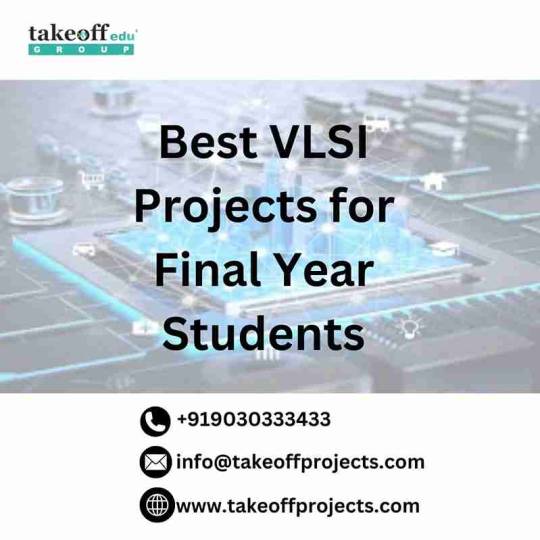
Best VLSI Projects for Final Year Students
Here are some great VLSI project ideas for final-year students:
1. Image Processing System on FPGA: Algorithm, such as edge detection or image filtering should be performed through the usage of FPGAs for optimal performance.
2. Low-Power SRAM Design: Design and simulate a low-power Static Random Access Memory (SRAM) cell, targetting leakage and dynamic power dissipation.
3. Digital Signal Processor (DSP) Design: Design an example of a DSP that will allow a specific signal to be filtered or, for instance, undergo FFT.
4. Wireless Sensor Network (WSN) Protocol Implementation: Devise a VLSI based sensor node for wireless communication that will support protocols used in data transmission.
5. Reconfigurable Hardware Architecture: It is necessary to elaborate a box which is able to evolve in order to support several applications: in this context, it is possible to try to reconfigure parts of the hardware during the runtime according to the specific needs of the client application.
6. Cryptographic Hardware Accelerator: Propose and design a device for which you could use cryptographic algorithms or primitives including AES or RSA where optimization of both speed optimization and security is important.
7. System-on-Chip (SoC) Design: Selected h/w architects use Verilog or VHDL to design a including microcontroller, memory and other peripherals.
8. Artificial Neural Network (ANN) on FPGA: Devise a mini ANN for image recognition and other related work and optimally use the features of parallel processing provisioned by FPGAs.9. Automated VLSI Testing Tool: Design a testing and validation software system that has reduced time and eliminated errors in conducting tests of VLSI designs (Very Large Scale Integration).
10. Temperature Sensor with Data Logger: It will be a VLSI (Very Large Scale Integration) chip for measuring temperature and recording data, with the capability to display the data on a PC or a mobile connection.
All these project proposals present prospects to learn diverse aspects of VLSI design and implementation in addition to enhancing creativity. Choose one that you are interested in and which you can afford to do!
#vlsi#finalyear#verylargescaleintegration#VLSIDesign#engineeringstudents#studentsprojects#takeoffedugroup#takeoffprojects
0 notes
Text
AMD Alveo UL3524 Sets STAC Benchmark World Record

AMD Alveo UL3524
Today’s top trading firms, market makers, hedge funds, brokerages, and exchanges compete for low-latency trade execution in complicated algorithmic trading, pre-trade risk assessment, and real-time market data delivery.
Achieving a minimal actional latency of 13.9 nanoseconds (ns) for trade execution, AMD, in partnership with Exegy, a global pioneer in advanced trading and execution systems, has set a world record for the STAC-T0 test. This is the fastest recorded STAC-T0 benchmark result to date and leads to a decrease of up to 49% in tick-to-trade latency when compared to the previous record. Prior top speed of up to 24.2 ns was also achieved by reference design with AMD accelerators.
With an emphasis on ultra-low latency electronic trading applications, AMD asked STAC to evaluate the AMD Alveo UL3524 FPGA Accelerator’s performance using STAC-T0 benchmarks.
The AMD Alveo UL3524 FPGA Accelerator on a Dell PowerEdge R7525 server with AMD EPYC 7313 processors housed the Exegy nxFramework and Exegy IP Core nxTCP-UDP-10g-ULL, which made up the stack.
When evaluating products that allow for quick analyses of time-series tick data, STAC benchmarks are the accepted industry standard. Regardless of whether a trading platform uses FPGAs, CPUs and software, or other hardware, STAC-T0 measures the tick-to-trade network-I/O latency of any platform with remarkable accuracy. The most important statistic in STAC-T0 is Actionable Latency, which is defined as the interval between the first bit of the simulated outgoing order and the last bit of incoming data required to make a trading decision.
AMD EPYC 7313 A Dell PowerEdge R7525 server with AMD EPYC 7313 processors, an Arista 7130 platform, and an Arista MetaWatch 7130 device were used to run the Exegy nxFramework and Exegy nxTCP-UDP-10g-ULL IP Core on the AMD Alveo UL3524 accelerator card, a FinTech card designed specifically for fast trade execution and powered by an AMD Virtex UltraScale+ FPGA.
With 1,680 DSP slices of computing, 780K LUTs of FPGA fabric, and a revolutionary transceiver architecture, the AMD Alveo UL3524 accelerator is a powerful tool. It is intended to speed up proprietary trading algorithms in hardware, allowing traders to customise their designs for proprietary algorithms and trading methods powered by artificial intelligence.
According to Girish Malipeddi, Director of Product Marketing at AMD’s AECG-Data Centre, “a nanosecond can determine the difference between a profitable or losing trade in ultra-low latency trading.” “This benchmark displays independently measured, validated, real-world outcomes that demonstrate how AMD is expanding the possibilities and limits in high-speed trading and financial technologies overall.”
To execute the requirements of the STAC-T0 benchmark on the Alveo UL3524 card, Exegy supplied the application, which included the required FPGA IP and related software.
Director of FPGA solutions at Exegy Olivier Cousin stated, “Exegy and AMD are thrilled to have set a record for the tick-to-trade latency with the completion of this latest STAC-T0 benchmark.” “The best published results to date are achieved by this year’s STAC-T0, which combines the new ultra-low latency TCP-UDP IP stack with Exegy’s FPGA programming framework.”
Overview Quick Trade Response The Virtex UltraScale+ FPGA, designed specifically for electronic trading, powers the Alveo UL3524. With a transceiver architecture that is revolutionary, the device may achieve a latency of less than 3 ns for world-class trade execution. This results in 7X better performance than existing FPGA technology.
Intended for Ultra-Low Latency (ULL) Operation Deterministic trade execution with transceiver delay of less than 3 ns for optimal performance
AI-Powered Trading Strategies and Personalised Algorithms Using both open-source PyTorch development flows and conventional FPGA design, developers may include low latency AI models into trading systems.
For a Wide Range of Fintech Uses Hardware acceleration for pre-trade risk assessment, market data delivery, and algorithmic trading
Adaptability of Hardware The AMD Alveo UL3524 accelerator card is designed to accelerate proprietary trading algorithms in hardware, allowing traders to adapt their design to changing market conditions and strategies. It has 64 ultra-low latency transceivers, 780K LUTs of FPGA fabric, and 1,680 DSP slices of computing.
For conventional FPGA flows, the Vivado Design Suite is compatible with the AMD Alveo UL3524 accelerator card. Additionally, AMD is making the open-source, community-supported FINN development framework available to developers, allowing the integration of low-latency AI models into high-performance trading platforms.
A competitive edge in the financial markets The AMD Alveo UL3524 accelerator can be used by brokerages, data vendors, market makers, hedge funds, proprietary trading businesses, and more for pre-trade risk management, market data distribution, and ULL algorithmic trading. High performance and determinism are guaranteed across a wide range of use cases by the convergence of low latency networking, FPGA flexibility, and hardware acceleration.
Algorithmic Trading ULL Market-making services to intricate algorithmic trading.
Risk Management Prior to Trade Assess pre-trade risk and ensure regulatory compliance with extremely low latency.
Supply of Market Data Deliver dependable real-time market data to exchanges and brokerages.
“A Dell PowerEdge R7525 server with AMD EPYC 7313 processors running Exegy nxFramework and Exegy IP Core nxTCP-UDP-10g-ULL on an AMD Alveo UL3524 FPGA Accelerator.” Configure the system to test: A Dell PowerEdge R7525 server with AMD EPYC 7313 processors and an Arista 7130 platform with a MetaWatch 7130 device, running the STAC-T0 benchmark test, is equipped with an AMD Alveo UL3524 accelerator card that is powered by an AMD Virtex Ultrascale+ FPGA.
Read more on Govindhtech.com
#AMDAlveoUL3524#AMD#AlveoUL3524#DellPowerEdgeR7525server#AMDEPYC7313#gpu#technology#technews#news#govindhtech
0 notes
Text
NO.1 VLSI System Design in India
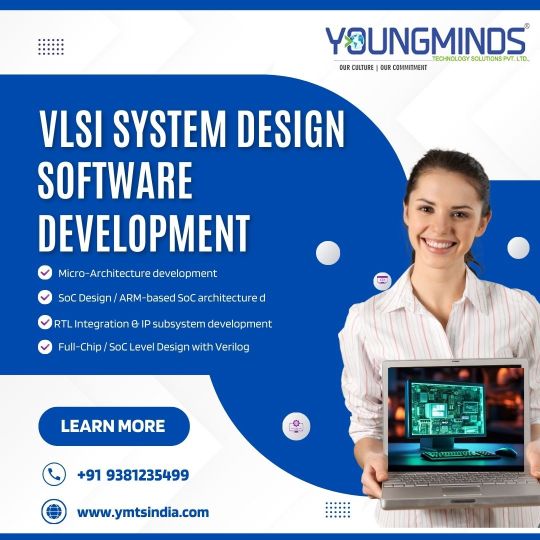
Welcome to Youngminds Technology Solutions, a leading VLSI System Design Software Development Agency in India. Our focus is on the development of the latest solutions that promote innovation and efficiency in the area of VLSI system design. Come with us as we are building the future of technology together.
Our VLSI design team has deep expertise in realizing product and software development for a wide range of application areas on cutting-edge technologies. YMTS team have wide set of skills across electronic chip design flow from specification to GDSII on latest node technologies, with special focus on RTL/FPGA Design, design verification and FPGA emulation.
VLSI SYSTEM DESIGN ASIC / FPGA Design Development
Design is not just what it looks like and feels like. Design is how it works.” You can hire us to build your custom website that fulfils your unique requirements. Unlike using a pre-built template for your site, a customized website is specifically created for you.
VLSI Services our Engineering team expertise in various stages of the design flow, Such as:
Micro-Architecture development for given specifications
SoC Design / ARM-based SoC architecture designs
RTL Integration & IP subsystem development
Full-Chip / SoC Level Design with Verilog, VHDL, System Verilog
Migration from FPGA to ASIC
Lint, CDC Checks and writing waivers
Integration of digital and analogue blocks (Like SERDES PMA + PCS or DDR + Phy etc.,)
Synthesis, STA Constraints for both ASIC and FPGA
Logic equivalency and formality checks
Hands-on experience on Various Industrial EDA tools
Optimization of Power, Area and timing trade off
FPGA Prototyping on Xilinx / Altera FPGA Boards
Optimization & Maintenance
We are here to help you understand the importance of web application maintenance. We provide several services which will enable your web application run error-free and smooth.
Our knowledge-based AI platform driven by automation and innovation. It enables our clients’ businesses to continuously reinvent system landscapes and achieve IT goals that align with business needs. By aligning IT with business value, we help clients push the envelope beyond cost and quality.
Training
YMTS provides training programs that help students / Engineers and customers get to productivity faster. All our training programs have been developed keeping in mind what it takes to accelerate skill development of today's R&D engineers and have been proven in-house with our own new hires as well as multiple customers.
As a top VLSI System Design Software Development Services, we are proud of the excellent services we offer. Our knowledge and dedication assure the best solutions for your VLSI requirements. Select us for the best performance in the VLSI system design. Visit More Information: https://ymtsindia.com/vlsi-system-design Meta Tags: VLSI System Design, VLSI System Management, VLSI Design Services, VLSI System Design Agency
0 notes
Text

Computer Science Dissertation Help
Ask assignmenter.net for assistance with your manuscript, lab report, and thesis in computer science. assignmenter.net has the expertise and knowledge to help with any computer science project related to advanced interfaces, such as ambient intelligence, markerless 3D hand tracking, or advanced processor technologies, such as big data, dynamic FPGA, graph theory, HPC interconnects, mesh networks, network layer routing protocols, wireless, voice over IP, or bio-health informatics, such as clinical text mining, DNA sequencing, or formal methods, such as automated reasoning, linear and nonlinear constraints, imaging science, information management, machine learning and optimization, nanoengineering, software systems, or text mining. Assignmenter.net Dissimilarity in Dissertation in Computer Science Although the term "computer science" has many different meanings, it generally refers to the systematic study of algorithms and computers, covering theory, analysis, design, efficiency, implementation, and application. In contrast to mathematics, physics, and other comparable traditional sciences, computer science (CS) has its roots in a wide range of disciplines, such as information systems, software engineering, and computer engineering. Moreover, it necessitated the application of ideas from numerous disciplines and integrated theory, practice, general abstraction, and design-specific principles. Discrete structures, programming fundamentals, complex algorithms, programming languages, architectures and organizations, operating systems, net-centric computing, human-computer interaction, graphical and visual computing, intelligent systems, information management, software engineering, social and professional issues, computational science, and numerical methods are some of the sub-areas of computing. assignmenter.net Any type of computer science The dissertation is handled with expertise. Theoretical computer science (conceptualization, modeling, analysis, data models, levels of abstractions, objects, and operations—iteration, recursion, and induction), building or designing software systems, programming languages, testing, process methodologies (design or construction of software systems and evaluation of human-computer interaction and understanding cognitive processes), experimental computer science (theory testing and exploration), and computer simulation (investigation beyond current experimental capabilities) are among the methodologies that computer science writers are skilled in handling. While drafting the research paper or dissertation, our staff will address six key questions: what is the problem (new or known), what has been done by others to address it, what is lacking, what has been planned, and what is the anticipated result. We put a lot of effort into creating your paper, but we also make sure you can successfully defend it. You can quickly regain concentration and make substantial progress on your computer science master's or doctoral thesis with the assistance of assignmenter.net. Over 5,000 Ph.D. thesis reports have been produced to date, and we have also provided help for publishing. Our team of pros includes Ph.D. and Master's holders in computer science who can help you write your Ph.D. paper successfully step-by-step. We put a lot of effort into creating your paper, but we also make sure you can successfully defend it. Our Ph.D. professionals in computer science, who are research advisors and post-doctoral fellows with rich research experience, will guide you through every step of the process, from choosing a topic for your computer science dissertation to writing and comprehending it. They will help you successfully complete and defend your master's and doctoral dissertations in computer science.
0 notes
Text
Machine Vision Technology for Enhanced Accuracy| iCORE

iCOREhas world-class researchers in the field of image processing with analog circuit design technology, precision instrument optics and beam design technology, and provides innovative image processing solutions by integrating electrical, electronics, optics, precision control, FPGA, firmware and software. By introducing products to meet the growing needs of customers, they have world-class technology personnel at home and abroad to provide the best solutions for customer satisfaction. The LED strobe driver provided by iCore generates and controls current pulses, enabling stable and precise strobe lighting of high-power LEDs. The machine vision technology provided by iCore uses advanced algorithms to enable machine vision systems to make precise assessments and perform complex tasks.
High-Speed & High-Power LED Strobe Controller, iPulse:
iPulse is a high-performance LED driver specifically designed for machine vision applications and based on iCore's unique expertise. The product can efficiently control high-speed currents. The world's first high-efficiency circuit developed by iCore can produce incredibly precise current pulses of less than 0.5 µm, even at 200 A or more. It uses high-power LEDs to ensure constant and precise strobe lighting.
Function Introduction of LED Strobe Controller:
iPulse is a constant current driver for LED lighting. The product takes advantage of constant current drive to provide up to ten times overdrive capability. Overdrive is a technology that instantly drives a current that exceeds the rated current of the LED to increase the brightness of the LED lighting many times. iPulse can power LEDs up to 200A, the highest in the industry, ensuring consistent LED current levels at all times. It also has a built-in function to limit the duration and duty cycle to protect the LED elements.
Auto Voltage:
Real-time detection and supply of voltage needed for LED driving
Reduction of heat generation by the controller
Driving of voltage higher than the supply voltage
Wide power supply selection
If you are looking forhigh-power led controllerin Korea, you can find it on iCORE
Click here to contactiCORE
View more: Machine Vision Technology for Enhanced Accuracy
0 notes
Text
Online VLSI Training Institutes and Best VLSI Courses in Bangalore by Takshila Institute
In the rapidly advancing field of Very Large Scale Integration (VLSI), staying updated with cutting-edge technology and industry trends is crucial for aspiring engineers and professionals. Among the leading names in VLSI training institutes in India, Takshila Institute of VLSI Technologies stands out as a prominent institution offering specialized online VLSI courses tailored to meet industry demands. With a strong emphasis on both theoretical knowledge and practical expertise, the institute provides comprehensive training to bridge the skill gap in the semiconductor industry.
The online vlsi training institutes programs offered by Takshila Institute of VLSI Technologies are designed to cater to students, fresh graduates, and working professionals who aspire to build successful careers in the semiconductor and electronic design automation (EDA) industries. These courses cover a wide range of topics, including Digital Design, Analog Design, RTL Design, FPGA Design, Verification Methodologies, and ASIC Design, ensuring participants gain in-depth knowledge and hands-on experience. The flexible online training modules allow learners to balance their education with other personal and professional commitments.
Takshila Institute of VLSI Technologies is renowned for offering some of the best VLSI courses in Bangalore, combining a robust curriculum with mentorship from industry experts. The courses are carefully crafted to align with current industry standards and requirements, ensuring that students are job-ready upon completion of their training. The institute also provides access to state-of-the-art tools and simulation software, enabling learners to work on real-world projects and case studies.
What sets Takshila Institute of VLSI Technologies apart is its focus on placement assistance and career development. The institute maintains strong ties with leading semiconductor companies, facilitating placement opportunities for its graduates. Regular workshops, mock interviews, and resume-building sessions are conducted to enhance employability skills.
The demand for skilled VLSI engineers in India continues to rise as the country becomes a hub for semiconductor manufacturing and design services. Enrolling in a course at Takshila Institute of VLSI Technologies not only equips learners with essential technical skills but also boosts their confidence to excel in a competitive industry.
In conclusion, for individuals seeking online VLSI training or the best VLSI courses in Bangalore, Takshila Institute of VLSI Technologies is a trusted name offering quality education, industry-relevant training, and excellent placement support. With a commitment to nurturing future-ready professionals, the institute plays a significant role in shaping the careers of countless VLSI enthusiasts across the country.
0 notes
Text
LED Light Strobe Controller for Enhanced Lighting | iCORE

iCORE has world classresearchers in the field of machine vision with analog circuit design technology, precision instruments optics and lightning design technology, provides innovative machine vision solutions by internalizing electrical, electronic, optical, precision control, FPGA, firmware and software technologies. Launching products that meet the growing needs of customers, they have top tech staff at home and abroad who offer the best solutions for customer satisfaction. The LED light strobe controller provided by iCore generates and controls the current pulses, enabling stable and precise strobe lighting of high-power LEDs.
High-Speed & High-Power LED Strobe Controller IP-8P8S-20A:
iPulse is a high-power LED controller designed especially for machine vision applications using iCore's exclusive expertise. High-speed current can be efficiently controlled by the product. The first high-efficiency power circuit in the world, created by iCore, can produce incredibly precise current pulses of less than 0.5㎲ even at 200A or greater. It makes use of high-power LEDs to provide steady and accurate strobe lighting.
Function Introduction of LED Strobe Controller:
iPulse is a constant current controller for LED lighting. The product utilizes the advantage of constant current driving to provide up to 10x Over-driving capability. Over-driving is a technology that instantaneously drives a current that exceeds the LED’s rated current to increase the LED lighting’s brightness by several times. iPulse can drive LEDs up to 200A, the highest in the industry, and assures constant LED current values at all times. It also has a built-in duration and duty ratio limiting function to protect LED elements.
Auto Voltage:
Real-time detection and supply of voltage needed for LED driving
Reduction of heat generation by the controller
Driving of voltage higher than the supply voltage
Wide power supply selection
If you are looking for led strobe controller in Korea, you can find it on iCORE
Click here to contact iCORE
View more: LED Light Strobe Controller for Enhanced Lighting
0 notes